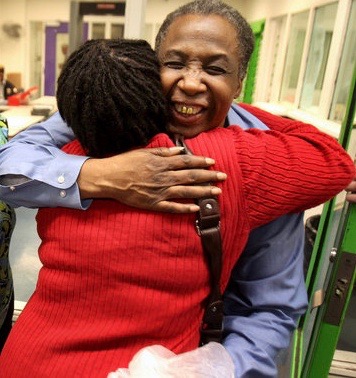 David Ayers (Marvin Fong, The Plain Dealer) On afternoon of December 17, 1999, the body of 76-year-old Dorothy Brown was found dead in her apartment on the fifth floor of a public housing development for the elderly and disabled in Cleveland, Ohio.
Brown’s skull was fractured and she suffered more than two dozen different wounds, some suffered in trying to fight off her attacker. She was nude from the waist down and several pubic hairs were recovered from her mouth and clothing.
Police focused their investigation on 42-year-old David Ayers, a housing development police officer who lived in the building as a condition of his job. When police arrived, they noticed that Ayers was “bawling” and his hands were shaking.
A resident of the building, Sarah Harris, told police that she and Ayers had gone to the victim’s apartment at 2 a.m. that day and helped her get up from the floor where she had fallen.
Harris discovered Brown’s body about 2 p.m.—12 hours later—and the door was closed, but unlocked.
Police believed that surveillance footage did not back up Ayers’ account of his visit to the apartment, so they accused him of lying.
Three months later, on March 14, 2000, Ayers was arrested for murder and he was indicted on March 27, 2000. He was not charged with any sex crime. The hairs did not belong to either Brown or Ayers.
On November 22, 2000, a jury was empanelled in Cuyahoga County Common Pleas Court. Five days later, on November 27, the prosecution revealed for the first time that it would call Donald Hutchinson, an inmate at the Cuyahoga County Jail. Hutchinson was in jail for passing forged checks and on a probation violation for other convictions of financial misconduct, theft and dishonesty.
According to Hutchinson, he met Ayers at a bible class in jail and Ayers talked to him about the murder and on several occasions thereafter. Just prior to the trial, Hutchinson said, Ayers “broke down” and confessed to murdering Brown.
Hutchinson reached out to police on November 25—three days after the jury was sworn in. Hutchinson didn’t have any details about the murder weapon or the amount of money taken.
However, less than two hours after meeting with police, Hutchinson was talking to Ayers again and the following day, Hutchinson reported to police that Ayers had confessed to beating Brown with an iron and stealing $700 in cash.
The trial judge rejected a motion to suppress Hutchinson’s testimony.
The prosecution also presented telephone records and a written statement from Kevin Smith, a friend of Ayers, that said Ayers called him prior to the discovery of the body to report that Brown had been murdered.
On the witness stand, Smith recanted portions of the written statement. He said two detectives pressured him to say the call came before the body had been discovered. The full video, which police had said did not back up Ayers’account, was finally aired and showed that Ayers had, indeed, been to the victim’s apartment in the early morning hours as he had claimed.
The jury convicted Ayers of aggravated murder, aggravated burglary and aggravated robbery on December 11, 2000. He was sentenced to life in prison without parole.
On appeal, the Ohio Court of Appeals affirmed his convictions, but ordered a new sentencing hearing. He was again sentenced to life without parole.
On January 29, 2003, the Ohio Supreme Court denied leave to appeal.
In January 2004, lawyers for Ayers filed a federal petition for a writ of habeas corpus. The petition was denied by a U.S. District Court judge.
While the habeas corpus case was pending, the Ohio Innocence Project filed a motion seeking DNA testing of the evidence in the case.
The prosecution opposed the motion and a legal battle ensued. That fight was interrupted on October 5, 2010, when the U.S. Court of Appeals for the Sixth Circuit overturned the district court and set aside Ayers’ conviction.
The court held that the alleged statements relating to the murder weapon and the money taken from the apartment were surreptitiously obtained by the state after charges had been filed, when Ayers had a constitutional right to not to be questioned without his lawyer being present.
The court found that detectives had intentionally created a situation likely to violate Ayers’ Sixth Amendment right to counsel when they sent Hutchinson back to the jail to specifically talk to Ayers about the murder weapon and money.
The court found that Hutchinson’s story was “both inconsistent and unreliable.”
After Ayers was granted a new trial, a newly assigned prosecutor sent all of the evidence, including the pubic hairs, the rape kit and a bloody towel, for DNA testing.
The tests excluded Ayers.
On September 12, 2011, the charges were dismissed and Ayers was released.
In March 2013, a federal jury found that two detectives, Michael Cipo and Denise Kovach, had fabricated and concealed exculpatory evidence and awarded Ayers $13.2 million in damages. The Sixth Circuit U.S. Court of Appeals upheld the verdict in December 2014. However, the city of Cleveland did not indemnify the officers. Cipo died and no claim was made against his estate. Kovach declared bankruptcy and the liability was discharged. A later lawsuit seeking to force the city of Cleveland to indemnify the officers to allow Ayers to collect the judgment was unsuccessful. The case was settled in 2020 after the city agreed to pay
Ayers $4.85 million.
In September 2017, Ayers filed a claim for compensation with the state of Ohio.
– Maurice Possley
|